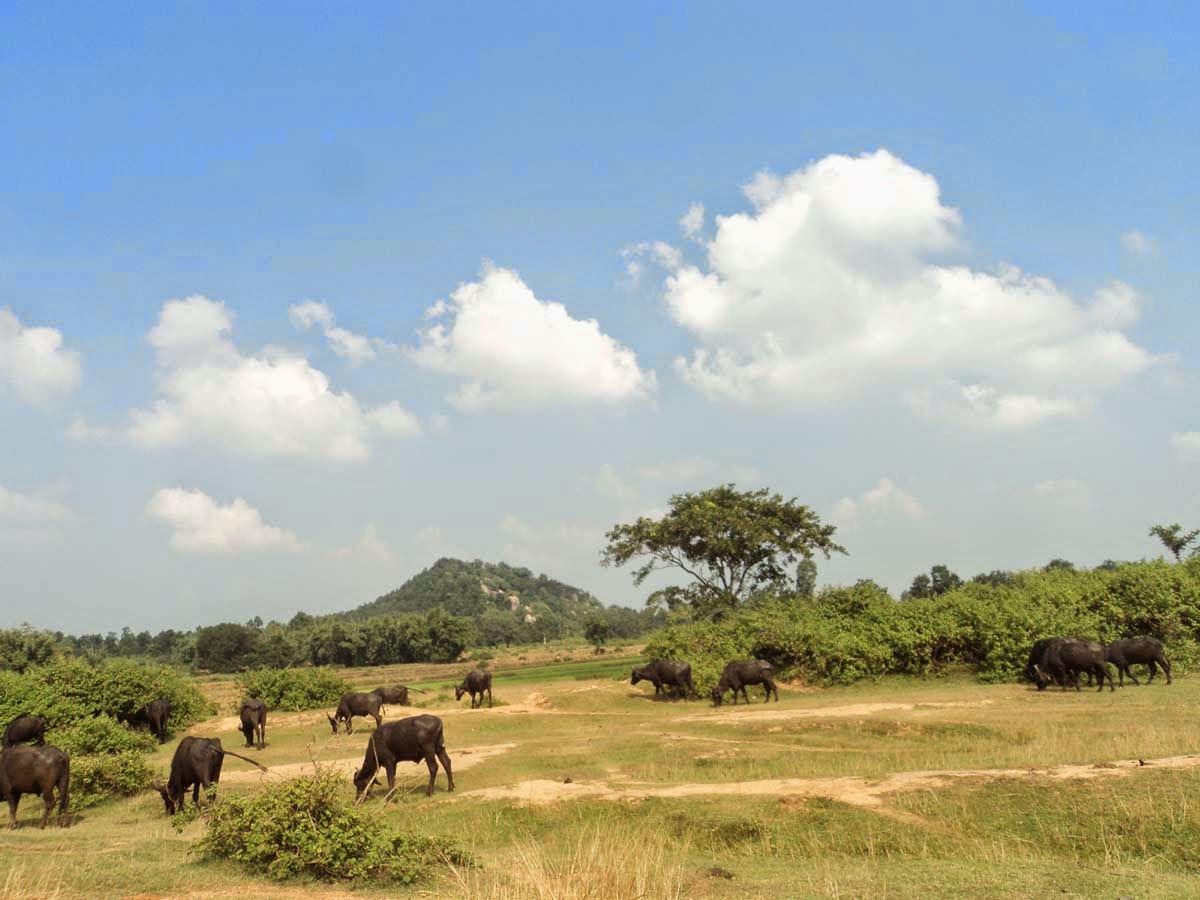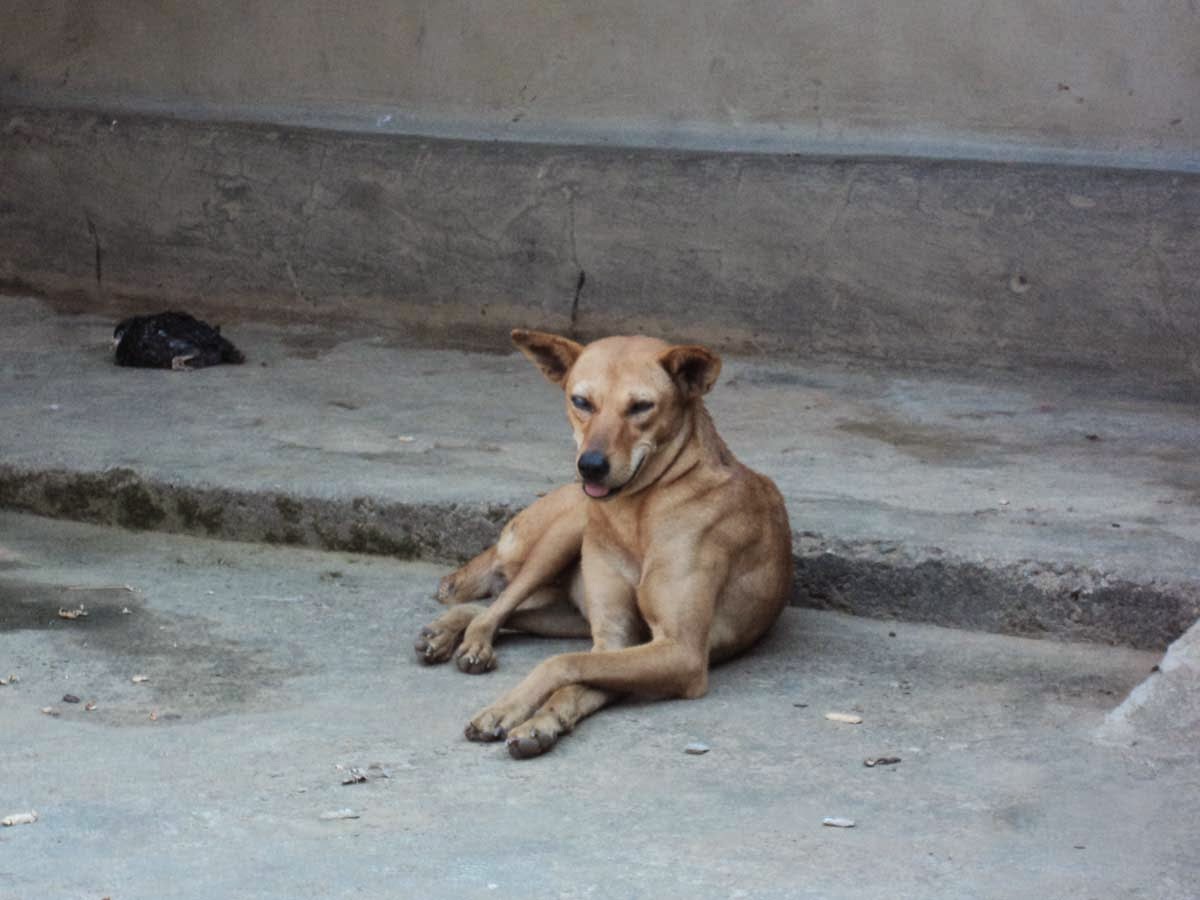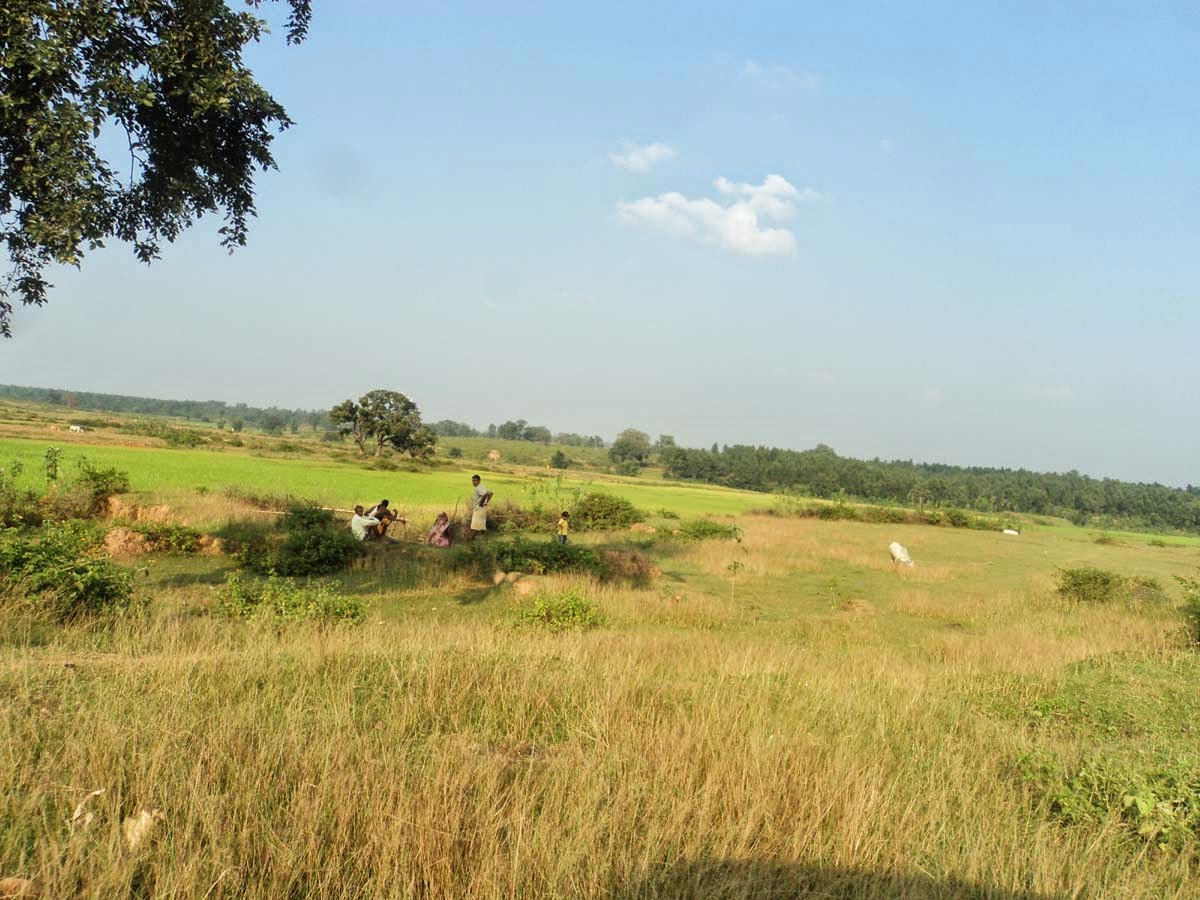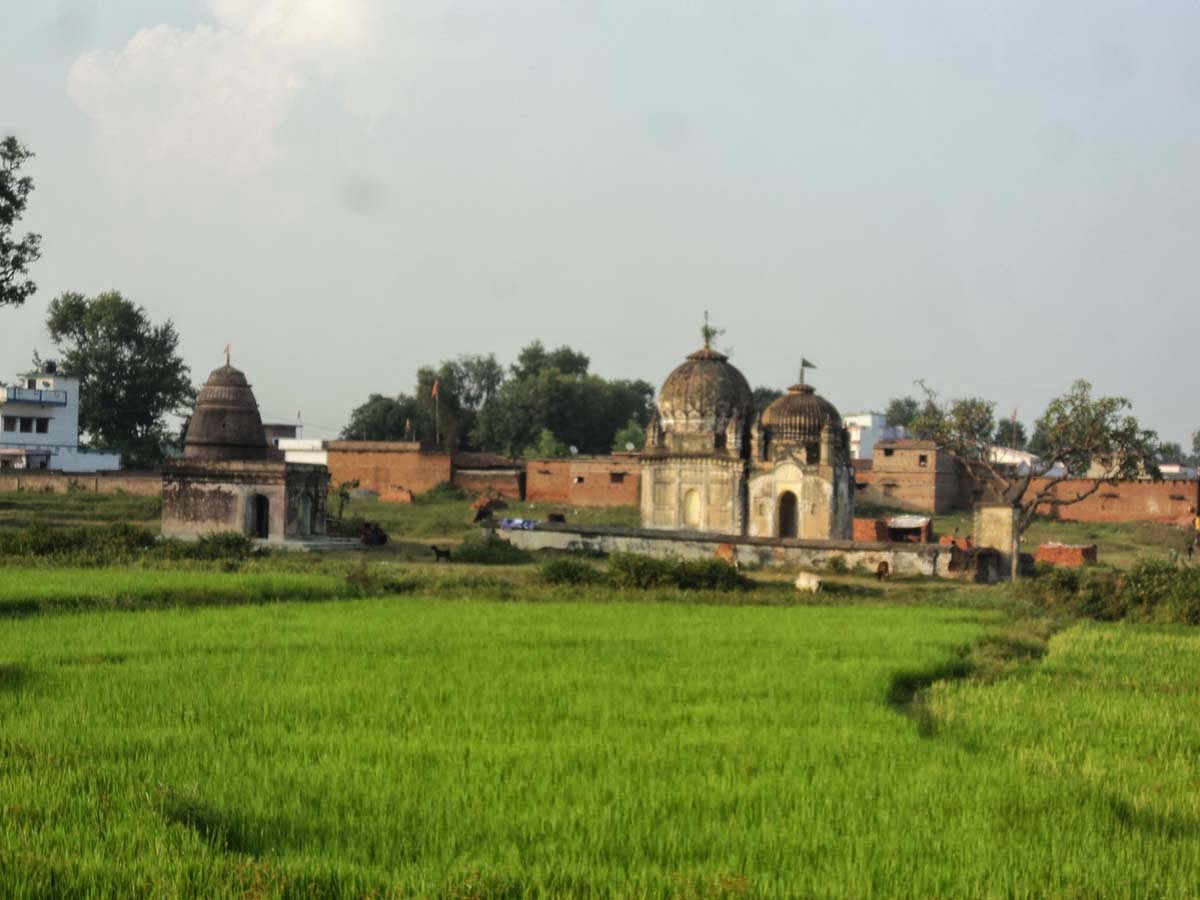 |
This
photograph was taken some eight years ago in the afternoon returning
from Bodhgaya and the picture was taken from the Bridge at Dhanua-Bhalwa
over the Mohania river. I did not then know that my daughter would one
day marry and live in the beautiful
estate on this river to the right hand side and not in the picture. It
is about midway between Chauparan and Dobhi and this photo was taken
before the present four-lane highway was made.
This
is the great Konya range at Bhalwa on Mohaniya river flowing from
Itkhouri to Bodhgaya down which Gautama Buddha walked from Tammasin to
where the Liraljan,Mohani and Phalgu meet at the sacred place of his
great Enlightenment at Bodhgaya. | |
.JPG) |
| A
Sakhua tree in spring floral foliage like an old lady in full golden
plumage of Banarsi silk. This tree is Sarjom to the Oraon, Saal to the
Santal, and Sakhua to the Munda. It is the Queen tree of the central
Indian forests east of the teak forests of
central India.It is the source of medicine and folklore that is
endless. Millions of hectares of saal jungles have been destroyed by
mega development projects for big dams (Narmada etc.) ,coal mines
(damodar valley), and industrialization across central India. |
.JPG) |
| Young
Saal trees in Spring foliage in the time of the spring festival of
Sarhul when according to Oraon belief in late April the marriage of the Sun and Earth takes
place... |
.JPG) |
| People
who endorse the mass cutting of such trees for coopicing forests such
as the British did had their eyes on the money for coppicing succeeds
with this tree, but those who cut it simply because they are widening
highways or making mines deserve to be shot. |
.JPG) |
| These saal trees are in the left side of the road before Tatijharia on way to Bagoder on S.H.33 |
 |
| The
Agaria tribals are descendants of the earliest iron workers, those who
quarried the iron-stone and carried it to the furnace where it was
wrought and smelted and produced in useful artiefacts. Their history
goes back three thousand years and is closelly
allied with the Asur iron workers. To me they are the forerunners of
the Celtic tribal movements in Europe and England. We must not forget
the world was smaller before without national boundaries and need for
visas and passports and all that nonsense. Man was man and this was his
world. We have in Tagore';s ringing words "divided this world into
narrow domestic walls". |
.JPG) |
| Well,
for one thing, they get all their minerals on their doorstep, even now.
The black comes from manganese in the fields near the jungles, and the
red Lal-mitti is found in the same vicinity. The white may be a little
problematic
since lime is never used, what is called Chuna, and the natural Kaolin
deposits are in the jungle; the best white Carks-mitti, comes from ochre
collection sites in the deep forests in caves, the remains of
pleistocene deposits and one such Chunatari will be destroyed right in
the centre of what will shortly become the Keridari mine block of
Reliance for their TPS in Tilaya; having said that briefly I may remind
readers that the black is not coal based as some think, not even in
mining areas. The houses are plastered with ordinary nagri or pila-mati
easily available in the family fields.I'm presently reading Lieutenant
Charles Low's record of Captain Cooke's voyages to where you now live,
and herecounts running into men who covered their faces and bodies with
red ochre and that practice of the Australian Aboriginal does not take
place here but red ochre never-the-less has a pre-eminent place in
Indian spirituality and it was when the Sacred took dominance about the
time of the Vedas before the iron age that Vermilion took its importance
which is absolutely non Aboriginal if I might say so.is not a mineral
but mercuric sulphite or chinese cinnibar which although held sacred for
indian womanhood in the parting of the hair of a married woman does not
have an aboriginal or adivasi significance... having said that,
however, in the recent sohrai paintings the scheduled caste women do
spot/daub with vermilion but it is a newfangled thing. |
 |
| The
sacred Bajha Sarna where hundreds of trees and hundreds of ancient
stone megaliths upto twelve feet in length, are found, some growing out
of the trunks of several hundred year old trees like banyan and peepul.
See "Bajha" in my book ANTIQUARIAN REMAINS OF JHARKHAND |
.JPG) |
| Sunset on sarguja and serso fields anywhere on the Hazaribagh plateau... |
.JPG) |
| This
is Hazaribagh. Cattle have always been celebrated by agricultural
societies. The village cows and bulls and buffaloes receive more care
and love than people anywhere in the world because they are a part of
village life, the agricultural calendar, and
a great lactate civilization which pre-dates Europe by several
millenia.This photo will likely be in the Barkagaon valley and the
gnarled trunk is of a Mohwa tree from its leaves... |
 |
| children
with their family's goats is a common sight in the Hazaribagh jungles
where they take the animals to graze on the lkeaves... |
.JPG) |
| I
don't know the precise location (Justin very likely took this snap) but
the stones at the foot of this great tree are Megaliths undoubtedly.
Readers of my new book ANTIQUARIAN REMAINS OF JHARKHAND will be happy to
see the note on the Bajha Sarna north of the National Park between
Katkumsandi and Dato Khurd because it is a sacred grove (Sarna) with
hundreds of ancient trees and hundreds of giant Megaliths... |
.JPG) |
| this is on the left bank of the Siwani river below the Siwani bridge 6 km before Tatijharia. |
.JPG) |
| Inside
you would find warmth in winter, shelter from rain, some cool from
summer heat, a flt sleeping floor with a round fireplace in the middle,
hunting nets and snares, baskets of forest produce and medicinal roots, a
few carrying poles and an axe of very small size... it is prehistory in the present... |
.JPG) |
| I
took this photo at 6 am in the morning while driving across the upper
Damodar between McCluskieganj and Balumath. About 45 kilometres from its
source in Latehar the river is as pristine as seen in the photo. Twenty
kilometres later the river plunges into the black filth of the North
Karanpura Coalfields Project's opencast coal mines. |
 |
| this
photo is at the northeastern corner of the Hazaribagh lakes facing the
setting sun.The Commissioner and Deputy Commissioner residences will be
behind the trees at extreme left side. |
 |
Standing
by my well in Dipugarha on a stormy monsoon evening some years ago I
saw this extraordianary after sunset monsoon evening scene and
immediately got my camera and clicked it. It is probably the best sky
scape I have ever photographed...
islands in the sky
great
expression "Islands in the Sky". Now wasn't that what Michelangelo saw
at Carrara that frosty morning before he got the inspiration to paint
"God created Adam" in the Sistine ceiling ? | | | | | |
 |
| This is a young silk cotton tree or Simul with its beautiful red flowers in full bloom in the Hazaribagh countryside. |
 |
On
the way from Hazaribagh to Katkumsandi when one crosses the Forest Rest
House on the hill opposit (north side, on right) there are bamboo
jungles and salai trees. I photographed these bamboos when they were
dying in their last flowering. In the rainy season the seeds will
re-germinate.
I
read somewhere that when the bamboo forests of the Chin hills in the
Northeast die the rats from Myanmar come in droves to eat the seeds. Has
anyone heard of this ? |
 |
| This
is the stone-cut door-way to enter the ancient Marwa-Dwar temple which
is a large underground labyrinth about a kilometre and half from the
Isco cave paintings. Near it is the famous Marwateri Cave. These are
extensively documented in my book ANTIQUARIAN REMAINS OF JHARKHAND under
"Isco". |
 |
| The
beautiful Jorakath lake ten kilometres south-west of Charhi and about 6
km from the new Charhi railway stationI have often compared this lake
with its flowering lotuses and flights of white herons to Valmiki's
descriptions of the wild natural beauties in Lord Ram's forest journey
in the Araniyakandam of the Ramayana. |
 |
this
is the Konar river just below where the Siwanee meets it. To reach here
drive down the Bagoder road about 25 kilometres to Kenduatoli village
(5 km after Tatijharia) and turn of the highway to the village, then
drive on a kuchha road about three kilometres
and walk the last two kilometres through Saal jungle to this most
beautiful stretch of the river which is about 35km upstream of the Konar
Dam. These are Hazaribagh's most precious offerings...
To
reach this stretch of the Konar just after its confluence with the
Siwanee drive five kilometres from Tatijharia, turn right and walk three
miles south through the forest. |
 |
| this is the lake (one of two) in the new park made in the old government farm after Demotand on the road to Ranchi. |
 |
| this is in the cafeteria opposite the Hazaribagh lakes. |
 |
| A most beautiful photograph of a typical Munda or Oraon mud house in the countryside somewhere in the Hazaribagh district |
 |
| this is the Heliograph tower on Tower Hill on way to Meru from Hazaribagh. |
 |
| Our beloved Canary Hill in Hazaribagh. |
 |
| This is the Sitagarha Hill also known as Juljul hill by the locals. Its is a natural recumbent figure here in perfect profile seen from the north. One knan see the knees, stomach and head of a recumbent goddess figure also known to native American Indians as an RLF or Recumbent Landscape Figure. The hill is an object of worship for the nomadic Birhors of the region on the south side of the hill not seen in the photo is a 50 foot high stone slab with a face form worshipped as Shiva by the local people and on the top of the stone slab during the Budh Purnima in the middle of May an offering of curds and rice is made by the local people to celebrate Buddha Jayanti. To the east of the Hill is a Buddhist site where Gupta period statuary have been found. The central portion of the hill seen in this photograph (belly) is the object of bombing and mortar firing by the Border Security Forces in Hazaribagh and despite 30 years of protest by INTACH to the highest authorities continues to this date. At the extreme right end on the top of the promontory there is a stone tank called Rani Pokhar. The hill is about 10 kms to the east of Hazaribagh town and well connected by road. |

 |
| The
road alongside the Chapri lake. If you go straight it will lead you
eventually to Badam, if you take the turn on the left you will go
through the remains of an old walled fort and in a few kilometres reach
Chapri (which is one of Hazaribagh's important
palaeolithic stone tool sites), crossing the source of the Dudhi Nala
you will reacxh the village of Saheda where the very famous Ganju Sohrai
artist Putli Ganju lives when not in Sanskriti. |
 |
| This
view tower was built in the 1950s by the late conservator of forests,
the legendary S.P.Shahi who was my first mentor in natural history
photography. |
 |
| This
avenue of banyan trees is just after Meru on way to Bagodar. If the
highway is four-laned (as planned) this avenue and all the other trees
for the next forty kilometers will be cut down. Whither India ?? |
 |
| This lake of white lotuses is near Canary hill and I will not tell where... |
 |
| the flowers in this photograph are the water-hyacinth |
 |
| These
silk cotton or Simul flowers are set against the background of the
proposed Magadh opencast coal mines northern Satpahar ranges, western
North Karanpura valley. They are a prophetic statement of doom. |
 |
| I
photographed this beautiful Laburnum tree (Bandarlauri/Tirki) tree
while walking down from the village of Saheda on the Hazaribagh plateau
to the Isco rock art site in the Barkagaon valley. |
 |
| This
avenue of trees is on the highway (S.H.33) from Hazaribagh to Bagodar,
and will be cut down when the proposed four-laning of the highway is
done. I have given up fighting about this, Anyone who has followed my
work on protecting highway trees from
the golden quadrilateral project will know that after reaching Dr
Manmohan Singh and the Chairman of the National Highways Project I
failed. I wrote extensively on it and a short search on google will
yield many of my writings. I am now given up to Fate in a completely
heartless world in which some people cut off other people's heads and
some cut off the heads of the roots of giant trees. |
 |
| This
photograph of winter crops was I think taken along the northern
escarpment of the Hazaribagh plateau facing the Barhi plain, that is
about six kilometres south-west of Tatijharia where the plateau falls
away steeply in forested ranges to the Barhi plain near Atka. |
 |
| Sarguja fields and bamboo blowing in the winter breeze on the Hazaribagh plateau. |
 |
| The
Siwani river bridge. I fear for this precious heritage monument when I
hear talks of four-laning the road from Hazaribagh to Barhi.Who can
explain these things to baboos ? |
 |
| The
Siwanee river below the bridge six kilometres before Tatijharia. In
about two kilometres from here the Siwanee will join the Konar river. |
 |
| This could be a trout stream in Alaska. No, its the winter waters of the Siwanee river in Hazaribagh. |
 |
| This
is a full view of the beautiful Jorakath lake in the Sati hill range
southwest of Charhi. I hestitate to name such places for fear that the
gods of evil development will seek them out and destroy them. When I
wrote my book ANTIQUARIAN REMAINS OF JHARKHAND
it was only to leave my hands with a sense of guilt that I had told an
unforgiving, cruel, mercantile world where the most precious places I
knew were, in the knowledge that they would seek them out and destroy
them. |
 |
| The lovely Jorakath lake about ten kilometres south-west of Charhi in the Sati hill range. |
 |
| the
MOST BEAUTIFUL lake in all of Hazaribagh. In the evening when the
peafowl call and a flight of white egrets streams across the lake and an
elephant trumpets in the closing darkness, then one is transported back
into Valmik's aranyakandam in Ramayana... |
 |
| this is another view of the Jorakath lake |
 |
| Mustard
fields in Mandair village with the Satpahar hill range having nine
rockart sites in the background. The entire are is subject to opencast
coal mining by the North Karanpura Coalfields Project, and big dams, and
how much longer such views will be available is left to be seen... |
 |
| A monsoon creek below a Kurmi village in the Hazaribagh countryside. |
 |
| Well
over twenty years ago I took this photo in the gentle North Karanpura
(Barkagaon) valley called rightly the "rice bowl of Hazaribagh). Now
this entire region faces the curse of opencast coal mining. The Mahudi
range is in the background. The location would be somewhere between
Barkagaon and Keridari... |
 |
| The
rock sheet one has to climb up to reach the Isco rock-art shelter, to
my mind one of the most beautiful landscapes in all Hazaribagh... |
 |
| The little Gossner Evangelical Lutheran Church of Singhani photographed by a very clever and attentive cameraman (Justin?)! |
 |
Mustard
fields somewhere on the Hazaribagh plateau... it seems there is a
defile beyond the horizon so it may be along the edge of the plateau at
some point.I am so in love with Hazaribagh that I would be happy to be
buried in any of its fields and prize it as an honour higher than
Westminster Abbey!!
These are Serso or mustard in foreground and the lemon coloured fields are Sarguja. |
 |
| MY Canary hills, and my wife Elizabeth's lands before they were pilfered by missions |
 |
| The Canary Hill is a landmark of the Hazaribagh town. |
 |
| This
is the edge of the Chatrupalu ghats before Baghchata and it goes
toward Tatisilwai on the Ranchi nplateau, and I hunted a rogue elephant
at a place called Angara about five miles to the right of the furthest
tip in the picture. In 1973 I hunted down
the four notrorious man-killing elephants of Ramgarh in these hill
ranges. In the extreme right-hand side is a small waterfall I named for
my daughter Cherry "JACINTA FALLS" and in the monsoon it still falls
briskly down a sheet of shining silver rock three hundred feet to the
valley below. Going up the ghat from Ramgarh it is just after the
Ramgarh-Ranchi district border. It is one of my love affairs with
Hazaribagh... |
 |
| On
a clear afternoon after a heavy shower of rain which has somewhat
cleaned the atmosphere of India's most polluted Damodar Valley, the Ruhr
of India, this picture is taken from the Chhatupalu Ghat looking east
toward Bokaro. |
 |
| Rajderwa
Forest Rest House in Hazaribagh National park conceived and built by
legendary Principal Chief Conservator of Forests Shri S.P.Shahi. It is
still there in sylvan serenity for anyone taking the six mile drive from
the Hazaribagh National Park gate on N.H.33 Hazaribagh-Barhi road. |
 |
| Village women returning in evening after rice transplanting in the fields all day. |
 |
| The Palash or Flame of the Forest in full flower in the month of April with the Sakhua or Saal trees in full blossom. |
 |
| A
woman transplanting rice seedlings, a common sight in the early monsoon
months and the only surprising thing is that she is pictured alone but
that may have been the photographer's perspective , since the "ropa" or
rice transplanting is done be rows of several women because literally
millions of little seedlings must be planted to fill the bread-basket
back home. |
 |
| The
Tilaya dam which submerged dozens of tribal villages and hundreds of
kilomtres of saal forests under a basin of water which is good enough
only for fishery or water for a super thermal power statiuon such as
Reliance is making but unequal to DVC's original plans of
hydroelectricity inspired by the Fifties ideas of the Nehru-Krushev
Vision for modern India... |
 |
| ditto, Tilaya Dam, in sytate of sedimentation... |
 |
| Boys bathing on a monsoon streamlet with a kind of fish-trap. These are flooded tice fields somewhere in Hazaribagh... |
 |
| These men are carrying the frames of string cots (Khatia) to the local market. |
 |
| The Padma or red lotus, symbol of India, with honey bee. |
 |
| This
is my late son Jason's mudden underground "bunker" room in the early
morning winter mist at my home Sanskriti in Dipugarha... |
.JPG) |
| In this view of the local Tower Hill at Silwar about 10kms east of Hazaribagh if one looks carefully one will find at the top middle a brick Heliograph tower used by the British uptil the time of the Mutiny of 1857 and on the right hand side a small protrusion at the top which is the upper part of a stone tortoise carved during the megalithic period. |
 |
| this beautiful tree is a Jacaranda which flowers during the months of March-April |
 |
| This
photo is from Laranga on the right bank of the Garhi river about ten
kilometres downstream from Tandwa where a mega-dam is vbeing built
submerging several villages. At Laranga we have found the rarest site of
industrial microliths produced 5000 years ago... |
 |
| Seen
from the Nautangwa Pahar rock-art site (See ANTIQUARIAN REMAINS OF
JHARKHAND "Nautangwa pahar") is the forest that Reliance is going to
turn into a huge opencast coal mine to supply its giant thermal power
plant project at Tilaya. In the right of centre
is a natural white earth (charki matti) ochre collecting site of the
village women from where they get the white earth for coating their
houses after the monsoon which are decorated with the famous Khovar and
Sohrai paintings. All this will be a memory in a few rivers. The Salga
river flowing below this view-point flows into the Garhi river on which a
dam is being built for the Tandwa Super Thermal Power project in which
dozens of villages have been displaced. Whither India ? |
.JPG) |
| The
Satpahar range in the background has no less than nine pre-historic
rock-art sites. The mud house in the foreground standing amidst mustard
fields is a symbol of the last ouposts against the massive coal mining
operations in the area being carried out under the North Karanpura
Coalfields Project which will reduce the Barkagaon valley to black
rubble... |
.JPG) |
| A magnificent Sakhua or Saal tree in full flowering during the Sarhiul or spring festival in late April. |
 |
| These rock formations are on the Garhi river near Tandwa in Chatra district. |
 |
| Sunset on the Mahudi ranges. |
 |
| These wooden posts are Gawaths erected in memory of ancestors by villagers.In background is a quaint looking Mohwa tree. |
 |
| This unusual formation of two trees joining over the road is on the Padma-Itkhori highway not far from Manjurhand. |
===========================================================
If
you miss Hazaribagh because of PHOTOS it makes me feel that at last I
have accomplished some thing of significance in my life of seventy-two
years!Q!































.JPG)
.JPG)
.JPG)
.JPG)

.JPG)

.JPG)
.JPG)

.JPG)
.JPG)
.JPG)
.JPG)




















































.JPG)



.JPG)
.JPG)



